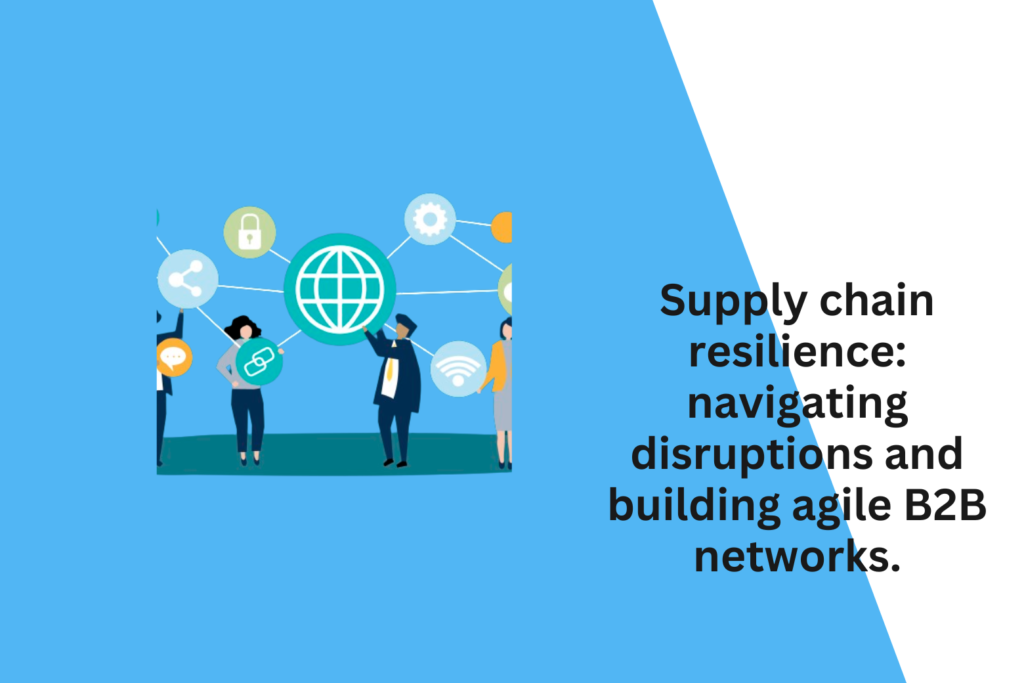
Supply chain resilience is critical for navigating disruptions and building agile B2B networks, especially in the face of challenges such as natural disasters, geopolitical events, and global crises. Here are strategies to enhance supply chain resilience in the B2B context:
1. Diversify Suppliers and Partners:
- Avoid overreliance on a single supplier or region. Diversify your supplier base to mitigate risks associated with disruptions in specific locations or industries.
2. Risk Assessment and Mitigation:
- Conduct comprehensive risk assessments to identify vulnerabilities in your supply chain. Develop strategies to mitigate identified risks and create contingency plans.
3. Real-Time Visibility:
- Implement technologies such as IoT sensors and data analytics to gain real-time visibility into the entire supply chain. This enables proactive decision-making in response to disruptions.
4. Collaborative Relationships:
- Foster strong collaborative relationships with suppliers, logistics partners, and other stakeholders. Open communication channels facilitate better response coordination during disruptions.
5. Flexible and Adaptive Supply Chain Design:
- Build flexibility into your supply chain design to accommodate changes in demand, disruptions, or shifts in market conditions. This may involve having alternative transportation routes or production facilities.
6. Supplier Relationship Management:
- Strengthen relationships with key suppliers. Work closely with them to ensure they also have resilient supply chains and can quickly adapt to changes.
7. Digitalization and Automation:
- Embrace digital technologies and automation to streamline and optimize supply chain processes. Automated systems can respond more quickly to disruptions and enable faster decision-making.
8. Inventory Buffer:
- Maintain strategic inventory buffers to mitigate the impact of supply chain disruptions. This includes safety stock for critical components or raw materials.
9. Scenario Planning:
- Conduct scenario planning exercises to simulate potential disruptions and develop response strategies. This proactive approach helps in preparing for various contingencies.
10. Continuous Monitoring and Feedback:
- Continuously monitor the performance of your supply chain and gather feedback from all stakeholders. Regular assessments allow for adjustments and improvements.
11. Resilient Logistics Network:
- Optimize logistics networks for resilience. This may involve having redundant transportation routes, multiple distribution centers, and diversified modes of transportation.
12. Investment in Technology:
- Invest in advanced technologies such as blockchain for enhanced traceability and transparency. These technologies contribute to a more resilient and secure supply chain.
13. Supplier Audits and Assessments:
- Conduct regular audits and assessments of key suppliers to ensure they meet established resilience and quality standards.
14. Cross-Functional Collaboration:
- Encourage collaboration between different departments, including supply chain, finance, and risk management. A cross-functional approach ensures a holistic understanding and response to disruptions.
15. Training and Skill Development:
- Provide training for employees involved in supply chain management. Equip them with the skills to respond effectively to disruptions and make informed decisions.
16. Regulatory Compliance:
- Stay informed about regulatory requirements and compliance standards related to supply chain resilience. Adhering to these standards can enhance the robustness of your operations.
17. Sustainability Practices:
- Integrate sustainability practices into your supply chain. Resilient supply chains are often built on sustainable and ethical practices that contribute to long-term viability.
18. Crisis Communication Plan:
- Develop a robust crisis communication plan to keep all stakeholders informed during disruptions. Clear communication helps manage expectations and build trust.
19. Post-Disruption Analysis:
- Conduct thorough analyses following disruptions to identify areas for improvement. Use lessons learned to enhance future resilience strategies.
20. Investment in Human Capital:
- Recognize the importance of skilled human capital in managing resilient supply chains. Invest in training programs to develop the necessary expertise within your organization.
By adopting these strategies, B2B organizations can not only navigate disruptions more effectively but also build agile and resilient supply chain networks capable of withstanding a variety of challenges. Resilience is an ongoing journey, and continuous improvement is essential to stay ahead of evolving risks and uncertainties.



